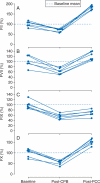Prothrombin complex concentrate mitigates diffuse bleeding after cardiopulmonary bypass in a porcine model
- PMID: 20716565
- PMCID: PMC2955534
- DOI: 10.1093/bja/aeq216
Prothrombin complex concentrate mitigates diffuse bleeding after cardiopulmonary bypass in a porcine model
Abstract
Background: Extracorporeal circuit priming and intravascular volume expansion during cardiopulmonary bypass (CPB) may lead to dilutional coagulopathy and excessive diffuse postoperative bleeding. Prothrombin complex concentrate (PCC) containing clotting factors II (FII), VII (FVII), IX (FIX), and X (FX) could be of potential value in correcting dilutional coagulopathy and reducing blood loss.
Methods: Anaesthetized pigs underwent CPB with hypothermia for 2 h at 25°C followed by 1 h of normothermia. Approximately 1 h after CPB, animals randomly received either isotonic saline 1 ml kg⁻¹ or PCC 30 IU kg⁻¹ in a volume of 1 ml kg⁻¹. Diffuse coagulopathic bleeding was assessed as suture hole blood loss from a Gore-Tex patch placed over a full-thickness incision in the left carotid artery.
Results: After CPB, levels of FII, FVII, FIX, and FX declined from baseline by 32% to 48%, and PCC fully or partially reversed those deficits. Median suture hole blood loss after administration of saline placebo was 74 ml. PCC reduced suture hole bleeding by a median of 54 ml with a 95% confidence interval of 6-112 ml (P=0.026) compared with saline. PCC, but not saline, normalized skin bleeding time. Peak thrombin generation markedly decreased after CPB, but then returned in PCC-treated animals to a level higher than baseline by 28.7 nM (14.5-41.1 nM; P=0.031).
Conclusions: PCC was effective in correcting dilutional coagulopathy and reducing diffuse bleeding in an in vivo large-animal CPB model. Further research is warranted on PCC as a haemostatic agent in CPB.
Figures




References
-
- Frankel TL, Stamou SC, Lowery RC, et al. Risk factors for hemorrhage-related reexploration and blood transfusion after conventional versus coronary revascularization without cardiopulmonary bypass. Eur J Cardiothorac Surg. 2005;27:494–500. doi:10.1016/j.ejcts.2004.11.021. - DOI - PubMed
-
- Choong CK, Gerrard C, Goldsmith KA, Dunningham H, Vuylsteke A. Delayed re-exploration for bleeding after coronary artery bypass surgery results in adverse outcomes. Eur J Cardiothorac Surg. 2007;31:834–8. doi:10.1016/j.ejcts.2007.02.001. - DOI - PubMed
-
- Salis S, Mazzanti VV, Merli G, et al. Cardiopulmonary bypass duration is an independent predictor of morbidity and mortality after cardiac surgery. J Cardiothorac Vasc Anesth. 2008;22:814–22. doi:10.1053/j.jvca.2008.08.004. - DOI - PubMed
-
- Mehta RH, Sheng S, O'Brien SM, et al. Reoperation for bleeding in patients undergoing coronary artery bypass surgery: incidence, risk factors, time trends, and outcomes. Circ Cardiovasc Qual Outcomes. 2009;2:583–90. doi:10.1161/CIRCOUTCOMES.109.858811. - DOI - PubMed
-
- Bull BS, Hay KL, Herrmann PC. Postoperative bypass bleeding: a bypass-associated dilutional (BAD) coagulopathy? Blood Cells Mol Dis. 2009;43:256–9. doi:10.1016/j.bcmd.2009.07.002. - DOI - PubMed
Publication types
MeSH terms
Substances
LinkOut - more resources
Full Text Sources
Other Literature Sources
Medical

